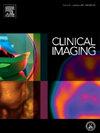标准乳房x线照相术与高分辨率数字乳房x线照相术筛查女性的结果
IF 1.5
4区 医学
Q3 RADIOLOGY, NUCLEAR MEDICINE & MEDICAL IMAGING
引用次数: 0
摘要
目的比较高分辨率(HR;70微米)和标准分辨率(SR;100微米)数字乳房断层合成(DBT)系统在现实世界的实践。方法:这项回顾性、观察性队列研究纳入了2013年至2023年在美国卫生系统接受乳腺癌筛查的40-79岁女性。报告肿瘤检出率(CDR)、召回率(RR)和召回阳性预测值(PPV1)。根据年龄、种族、密度、风险状态、先前解决方案、设施和放射科医生进行调整后,使用逻辑回归估计HR与SR DBT的每个结果的几率。另外的分析评估了先前进行乳房x光检查对结果测量的影响。结果共纳入184,006张x光片(SR 95,633张,HR 88,373张)。CDR分别为5.38/1000 (HR)和4.87/1000 (SR) (p = 0.1296)。校正潜在混杂因素后,HR增加的癌症检出率具有统计学意义(OR = 1.370, 95% CI:1.117, 1.681)。RR分别为9.80% (HR)和9.07% (SR) (p <;0.0001),调整后OR为1.392 (95% CI:1.327, 1.460)。PPV1相似:5.57%(人力资源),5.45% (SR) (p = 0.2730)。对于已知病史的检查,CDR为5.38/1000 (HR)和4.22/1000 (SR) (p = 0.0020), RR为9.39% (HR)和7.80% (SR) (p <;0.0001), PPV1分别为5.74% (HR)和5.49% (SR) (p = 0.0437)。对于已知病史的HR检查,RR为10.00% (SR先验)和9.14% (HR先验)(p = 0.0001)。结论:这项大型的真实世界研究表明,HR DBT比SR DBT与更高的CDR相关,对于已知病史的检查,CDR的增加更大。本文章由计算机程序翻译,如有差异,请以英文原文为准。
Mammography screening outcomes for women screened by standard versus high resolution digital breast tomosynthesis
Objective
This study compared breast cancer screening outcomes between high resolution (HR; 70-micron) and standard resolution (SR; 100-micron) digital breast tomosynthesis (DBT) systems in real-world practice.
Methods
This retrospective, observational cohort study included women ages 40–79 screened for breast cancer at a U.S. health system from 2013 to 2023. Cancer detection rate (CDR), recall rate (RR), and positive predictive value of recall (PPV1) were reported. The odds of each outcome following HR versus SR DBT, adjusted for age, race, density, risk status, prior resolution, facility, and radiologist, were estimated using logistic regression. Additional analyses assessed the impact of having prior mammograms on outcome measures.
Results
A total of 184,006 mammograms were included (95,633 SR, 88,373 HR). The CDR was 5.38/1000 (HR) and 4.87/1000 (SR) (p = 0.1296). The increase in cancer detection with HR was statistically significant after adjusting for potential confounders (OR = 1.370, 95 % CI:1.117, 1.681). The RR was 9.80 % (HR) and 9.07 % (SR) (p < 0.0001), with an adjusted OR of 1.392 (95 % CI:1.327, 1.460). PPV1 was similar: 5.57 % (HR), 5.45 % (SR) (p = 0.2730). For exams with a known prior, the CDR was 5.38/1000 (HR) and 4.22/1000 (SR) (p = 0.0020), the RR was 9.39 % (HR) and 7.80 % (SR) (p < 0.0001), and the PPV1 was 5.74 % (HR) and 5.49 % (SR) (p = 0.0437). For HR exams with a known prior, the RR was 10.00 % (SR prior) and 9.14 % (HR prior) (p = 0.0001).
Conclusions
This large, real-world study demonstrated that HR DBT is associated with a higher CDR than SR DBT, with a greater increase in CDR for exams with a known prior.
求助全文
通过发布文献求助,成功后即可免费获取论文全文。
去求助
来源期刊

Clinical Imaging
医学-核医学
CiteScore
4.60
自引率
0.00%
发文量
265
审稿时长
35 days
期刊介绍:
The mission of Clinical Imaging is to publish, in a timely manner, the very best radiology research from the United States and around the world with special attention to the impact of medical imaging on patient care. The journal''s publications cover all imaging modalities, radiology issues related to patients, policy and practice improvements, and clinically-oriented imaging physics and informatics. The journal is a valuable resource for practicing radiologists, radiologists-in-training and other clinicians with an interest in imaging. Papers are carefully peer-reviewed and selected by our experienced subject editors who are leading experts spanning the range of imaging sub-specialties, which include:
-Body Imaging-
Breast Imaging-
Cardiothoracic Imaging-
Imaging Physics and Informatics-
Molecular Imaging and Nuclear Medicine-
Musculoskeletal and Emergency Imaging-
Neuroradiology-
Practice, Policy & Education-
Pediatric Imaging-
Vascular and Interventional Radiology
 求助内容:
求助内容: 应助结果提醒方式:
应助结果提醒方式:


